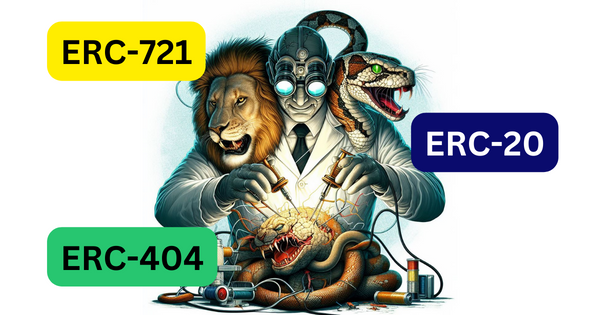ERC-404: Revolution or Fad? Pandora Unlocks Fractional NFTs & Asset Ownership Redefined
The world of cryptocurrencies and blockchain-based assets is constantly evolving, with new standards and protocols emerging to unlock novel functionalities and possibilities. One such recent development is ERC-404, an experimental standard attempting to bridge the gap between fungible tokens (ERC-20) and non-fungible tokens (NFTs) (ERC-721).
What is ERC-404?
Think of ERC-404 as a Frankenstein's monster, creatively stitching together elements from both ERC-20 and ERC-721. On one hand, it offers fungibility, meaning individual units are indistinguishable like traditional currencies. On the other hand, it introduces a level of uniqueness similar to NFTs, allowing for the creation of distinct tokens with specific properties. This opens up exciting possibilities for asset representation and interaction within the blockchain ecosystem.
Here's the key: ERC-404 achieves this "semi-fungibility" through a technique called pathing. Essentially, it packs both token amount data and identifiers into a single unit. However, this pathing comes with certain trade-offs, as the standard is still experimental and have not thoroughly vetted through the official Ethereum proposal process.
Popularity Surge: Pandora Sets the Stage
The recent buzz surrounding ERC-404 can be attributed largely to the launch of Pandora, the first project built on this standard. Pandora allows users to fractionally own unique assets represented by ERC-404 tokens. Imagine co-owning a rare digital artwork or even a physical asset like a piece of real estate, all divided into tradable fractions on the blockchain.
Pandora's explosive price surge (a 13x increase at one point as of the time this article wrote) further fueled the hype, showcasing the potential of ERC-404 for innovative asset representation and fractional ownership. However, it's crucial to remember that this comes with inherent risks, as the standard is still in its early stages of development and lacks the rigorous testing and community backing of established standards like ERC-20 and ERC-721.
Beyond Pandora: The Future of ERC-404
While the focus might currently be on Pandora, the implications of ERC-404 extend far beyond a single project. Its ability to combine fungibility and uniqueness could pave the way for a new wave of creative applications:
Fractionalized ownership of real-world assets: Imagine co-owning a rare collectible, a piece of art, or even real estate through ERC-404 tokens.
Dynamic NFTs: NFTs could evolve over time, with their properties changing based on external factors or community decisions.
New DeFi opportunities: Fractionalized ownership could unlock innovative lending and borrowing mechanisms within the DeFi landscape.
However, it's important to reiterate the experimental nature of ERC-404. Thorough testing, community vetting, and further development are crucial before widespread adoption. Investors and users should exercise caution and conduct their own research before diving into this novel standard.
The future of ERC-404 remains uncertain, but its potential to bridge the gap between fungible and non-fungible tokens is undeniable. Only time will tell if it can overcome its limitations and become a key player in the ever-evolving blockchain landscape.
UD is a leading blockchain and network security solution provider in Hong Kong. We are dedicated to assisting enterprises in advancing their businesses through innovative blockchain technology, ushering in a new era from Web 2.0 to Web 3.0.






